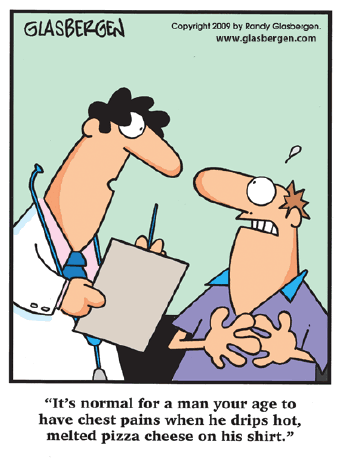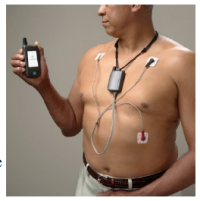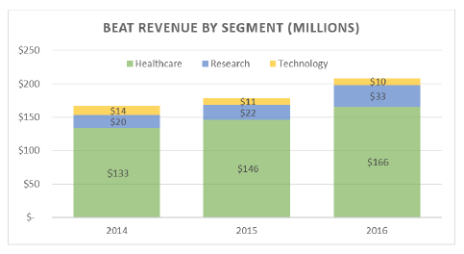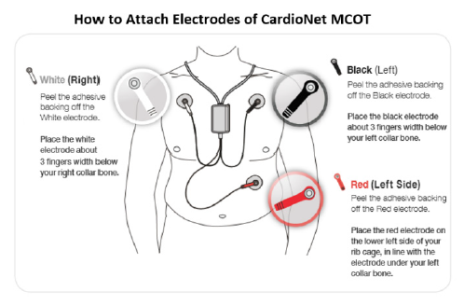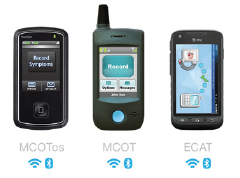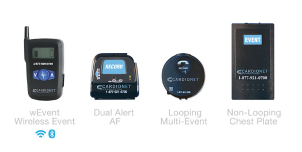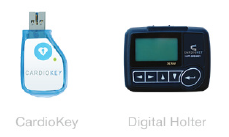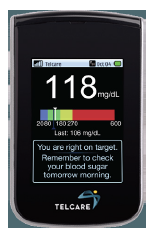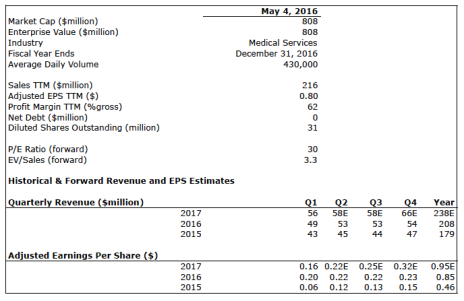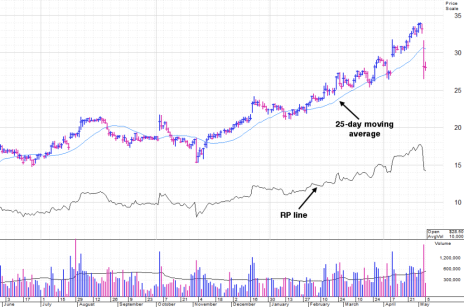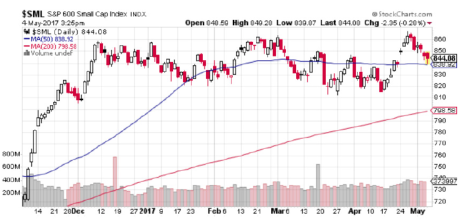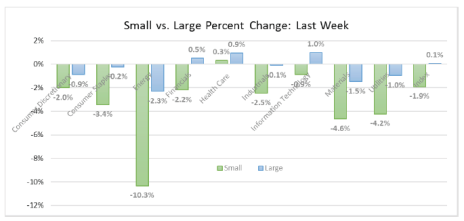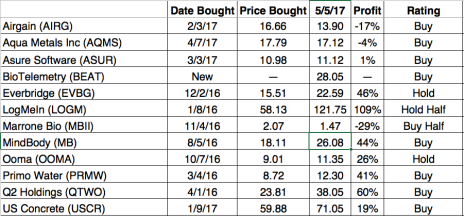Today’s candidate provides digital health solutions to people with chronic health issues. Its biggest market is people with heart conditions, but it is branching out to the diabetes market as well. For a short window of time, I believe we can establish a position while shares are “on sale.”
Small Cap 216
[premium_html_toc post_id="133773"]
THE BIG IDEA
How is your heart doing?
This might not be a question you’ve given much thought to. Especially if you’ve never suffered from an irregular heartbeat.
But if you’re among the five million Americans affected by cardiac arrhythmias, you probably want to know the answer. And fortunately, with the emergence of mobile cardiac telemetry (MCT) monitoring equipment, access to lifesaving heart rhythm data is available 24/7, whether at the hospital, at home or out on the golf course.
An arrhythmia is a problem with the rate or rhythm of the heartbeat. A heartbeat that is too fast is called a tachycardia. One that is too slow is a bradycardia. Often, patients with arrhythmias go to the hospital after feeling chest pain, dizziness, shortness of breath or experiencing a seizure.
A physician performs a common cardiology test, called an electrocardiograph (ECG or EKG). A monitor is hooked up to electrodes that are placed on the skin to detect the tiny electrical changes from each heartbeat. The ECG graph is read by a trained professional to see if the electrical activity is normal, to better understand the size and position of heart chambers, see if there’s any damage to the muscle, evaluate the effect of drugs or assess how well implanted devices (like pacemakers) are working.
In a lot of cases, people with heart conditions receive diagnostic benefits from extended monitoring, which is no longer restricted to the hospital. Advances in mobile health technologies mean many of these patients can be monitored remotely, while benefiting from fast and accurate diagnosis with the aid of MCT monitoring. They just need to wear a wireless device that’s connected to electrodes stuck to their skin. Those electrodes do the same thing as the ones in the hospital. And the data is beamed to a monitoring center via cell phone or the Internet, where trained staff can review it.
The benefits of remote cardiac monitoring are tremendous. For starters, the best MCT equipment offers incredible accuracy and speed to diagnosis. These are often the deciding factors for the treating physician. Second, patients don’t need to sit in a hospital bed waiting for an irregular heartbeat or other event that might come at an unpredictable time. They can go about their lives with a reasonable degree of normalcy. And in many instances, continuous monitoring over days and weeks helps inform better treatments and lifestyle changes that might have been difficult to prescribe if heart monitoring was only done during a short window.
Then there are the cost savings. Cardiovascular disease is the world’s leading cause of death. Millions of people recovering from surgery, at risk of heart events and/or living with chronic heart conditions represent a strain on healthcare providers. Remote cardiac monitoring saves doctor visits, means many patients can be monitored with just a few trained staff members, and cuts long-term care costs through early and accurate diagnosis.
For these reasons, remote cardiac monitoring is gaining popularity around the globe. A watershed moment occurred in the U.S. in 2008-2009 when cardiac telemetry devices were first recognized under their own billing code by insurance companies and Medicaid. After a few years of working through details of reimbursement rates, the market began to stabilize, fueling growth in monitoring devices, monitoring centers and even dedicated remote cardiac monitoring wards at hospitals.
Globally, cardiac monitoring is a roughly $22 billion market, growing at around 5% annually. Home and ambulatory (outpatient) monitoring appear to be growing the fastest. There are also pockets of growth in hospitals and research services (like drug trials).
As with most medical devices, getting physicians on board is one of the biggest obstacles to companies in this market after the devices have gained FDA approval. Physicians need to have confidence in the technology. And a company can benefit from having a wide enough variety of monitoring devices so the treating physician can properly tailor the monitoring device to the patient’s specific needs.
For instance, a traditional Holter device is typically used to monitor heart irregularities during a short window of one to two days. But newer devices can continuously monitor a patient’s heart for up to a month. That longer window of monitoring time dramatically increases the chances of capturing an abnormal event.
MCT monitoring isn’t an emerging technology, given that it’s become the standard of care in many instances. But it’s not a mature market either. It remains fragmented, with many market participants, ranging from big to small.
Near the low end of the market-cap curve, there is one small-cap company that has emerged as a market leader in MCT monitoring. It owes its success to the accuracy and reliability of its patented technology, an innovative culture that continues to design comfortable and intuitive-to-use devices and a growing network of loyal prescribing physicians. This is the company I profile in today’s Issue of Cabot Small-Cap Confidential.
I believe the company is on the cusp of accelerating sales as it introduces new remote cardiac monitoring devices, expands into monitoring for chronic conditions beyond the heart, and gets closer to closing a major acquisition that will immediately increase revenue by over 50%.
THE COMPANY/PRODUCT
BioTelemetry (BEAT) provides digital population health management (PHM) services within the healthcare system. Its current focus is remote cardiac telemetry (RCT) monitoring. It is also working to expand its PHM services beyond the heart and into the remote diabetes management market with a newly introduced remote blood glucose (BCM) monitoring solution. The company is a vertically integrated medical device manufacturer, meaning that it builds all its own monitoring devices and accessories. It has a market cap of $795 million.
The company has been a pioneer in remote cardiac monitoring since it began in 1994 in San Diego. Back then, it was known as CardioNet. It developed the first mobile outpatient telemetry system in the industry. The system included a proprietary integrated patient management platform based around a wireless data network, FDA-cleared algorithms and medical devices, and 24/7 monitoring service centers. Its first device was FDA approved in 2002, when the first CardioNet monitoring center opened for business.
The next decade was a tumultuous time for the young company. A 2008 IPO was initially a big success, then the reimbursement rate environment destabilized in the middle of the Great Recession, and shares fell from grace. Revenue of $141 million in 2009 represented the high-water mark, and by 2012, the company was only generating $112 million in annual revenue.
Things turned around in 2013 as CardioNet moved into the next stage of its lifecycle, beginning with changing the name of the company to BioTelemetry. Over the next couple of years, it made a number of meaningful acquisitions, introduced new products, forged strategic alliances, and published vigorous studies showing the efficacy of its Mobile Cardiac Outpatient Telemetry (MCOT) devices. Revenue hit $130 million in 2013, then reached $179 million in 2015. That same year, BioTelemetry divided the company into three different divisions to prepare for the next stage of growth in the digital PHM market.
Today, the company monitors over half a million patients a year and supports over 20,000 physicians and sites. It has 29 U.S. patents and 34 international patents. Over 50,000 of its monitoring devices are out in the market. Those devices process over two billion heartbeats a day, and have generated over a million reports to physicians. This all means quicker diagnosis for patients, a better quality of life and lower costs to the health care system. It also means a more stable business. Quarterly revenue has been rising, both sequentially and year-over-year, since the third quarter of 2015.
BioTelemetry reports revenue from three segments: Healthcare, Research and Technology. Healthcare, which covers the diagnosis and monitoring of cardiac arrhythmias (hearth rhythm disorders) is by far the biggest, representing 79% of revenue in 2016. The Research segment provides services for drug and medical device trials, and generates 16% of revenue. The Technology segment makes and sells medical devices; it generated 5% of revenue last year.
Each division is home to different solutions and market-facing brands, so let’s go through each one separately.
Healthcare: CardioNet and Heartcare
The CardioNet and Heartcare businesses are focused on diagnosing and monitoring cardiac arrhythmias. They provide cardiologists and electrophysiologists with a wide range of solutions, all of which include a monitoring device worn by the patient and some form of data collection, transmission and remote analysis/support. Healthcare solutions are broken down into five main product categories, the first three of which generate the most revenue. Total Healthcare revenue grew by 13% in 2016.
Mobile Cardiac Telemetry solutions are marketed as the Mobile Cardiac Outpatient Telemetry (MCOT) and External Cardiac Ambulatory Telemetry (ECAT) services. Both include a patient-worn sensor with electrodes that collect two-channel electrocardiogram (ECG) data and store it on a compact wireless handheld monitor. The monitor analyzes every heartbeat in real time using proprietary algorithms to detect arrhythmias. When an arrhythmic event occurs, the ECG data is automatically sent to one of BioTelemetry’s 24/7 Monitoring Centers where specialists analyze the data and follow protocols prescribed by the patient’s physician. All MCOT and ECAT devices continuously transmit data between Monitoring Centers and patients so physicians can remotely adjust monitoring parameters and review ECG data. These devices store up to 30 days of data, far more than the maximum 10 minutes of typical event monitors, and well above the 24 hours of a typical Holter monitor. The company recently introduced its next generation MCOT device, the MCOT Patch. This is a four-lead, two-channel system that encompasses the same core technology but is offered in a more convenient form for patients.
Wireless and Trans Telephonic Event solutions give physicians the flexibility to prescribe wireless event monitors, digital loop event monitors, memory loop event monitors and non-loop event monitors. These devices use algorithms to detect and transmit asymptomatic and symptomatic events (atrial fibrillation, tachycardia, bradycardia, cardiac pause). Depending on the physician’s choice of device, data is sent to BioTelemetry event monitoring centers, either wirelessly or through telephonic transmission of stored event data.
Holter monitors were developed in the 1950s and have been used commercially since the early 1960s. BioTelemetry developed a range of Holter solutions for the large number of physicians who don’t want to change how they do things. The company offers both traditional and extended-wear options that store heart beat data on compact flashcards that Holter labs review after receiving in the mail or through a secure web transfer portal. BioTelemetry introduced its next-generation Holter monitor, the lightweight CardioKey, in 2015. It stores up to 14 days of cardiac images. On its Q4 2016 conference call, management said it has already sold over 22,000 CardioKeys. That number went up to nearly 30,000 in Q1 2017, suggesting that this product has been a real success.
International Normalized Ratio (INR) and Pacemaker monitoring solutions are smaller businesses. INR solutions were developed for patients on anti-coagulation therapies who are authorized by their physicians to self-monitor INR levels. The patients test their own blood samples and INR values are submitted through the CardioNet web portal or mobile app.
Research: Cardiocore and VirtualScopics
The Research segment provides lab services to pharmaceutical companies and contract research organizations all over the world that are running drug and medical treatment/device trials. Most services are for ECG, Holter monitoring, ambulatory blood pressure monitoring, echocardiography, multigated acquisition scan, imaging services, protocol development and data management, reporting and analysis. Clients can access data through the cloud-based CardioPortal web service. Research revenues grew by $10.7 million (nearly 50%) in 2016, largely because of the $15 million acquisition of VirtualScopics in May. This acquisition beefed up BioTelemetry’s imaging services (cardiovascular, oncology, musculoskeletal, etc.).
Technology: Braemar Manufacturing, Universal Medical and BioTelemetry Technology
The Technology segment manufactures all the cardiac monitoring devices used in BioTelemetry’s Healthcare segment. It also sells cardiac monitors to other healthcare companies. Revenues are a small slice of the total pie (5%) and were down by 6% in 2016. However, it should be noted that BioTelemetry’s vertical integration strategy means it avoids paying a markup on devices that it provides to patients since it makes them in-house.
The existence of this division also provides a platform for future growth of medical devices and associated services. In 2016, BioTelemetry acquired the ePatch division of DELTA (for $6.5 million), paving the way for a broader rollout of devices and services using the patch form factor. And in December 2016, it acquired Telcare (for $9.7 million). Telcare is the first company to receive FDA clearance for a cellular-enabled blood glucose monitoring (BGM) system. The wireless BGM system sends results in real time to a cloud-based analysis platform that runs the data and sends caregivers updates and alerts. Diabetic patients receive personalized, contextual messages right on their BGM meter’s screen.
This acquisition marks BioTelemetry’s first major departure from heart monitoring and sets the company on a path to better address the incredibly large Population Health Management (PHM) market. The general idea with PHM is that the vast majority of health care system costs (roughly 80%) come from patients with chronic conditions. There is tremendous incentive to reduce ER visits, hospital stays, etc. for these patients to help reduce overall cost of care. Diabetes is one of the major chronic conditions (along with COPD, asthma, depression and congestive heart failure) that contributes to soaring health care costs, with estimated direct annual costs of over $245 billion. I’ll update you as this part of the story unfolds.
The Next Stage of Growth: LifeWatch AG
On April 9, BioTelemetry announced its intent to launch a tender offer to acquire its largest competitor, Switzerland-based LifeWatch AG. The strategic rationale for the acquisition—besides to knock out a major competitor—is to help BioTelemetry grow into a connected health powerhouse! The main focus of the business will continue to be remote cardiac monitoring, since that’s what LifeWatch brings to the table. But other benefits, such as access to LifeWatch’s overseas markets, relationships, sales staff, etc. should help BioTelemetry expand other lines of business, like the acquired Telcare BCM business.
LifeWatch’s core business is focused on Mobile Cardiac Telemetry, Cardiac Event and Holter Monitoring systems. It launched a monitor with the patch form factor in the U.S. last year which has been ramping up, and just recently launched its services in Turkey.
This is a significant acquisition. The price at the time of the offer was $257.4 million, which works out to roughly 2.2-times LifeWatch’s 2016 revenue of $113.8 million. BioTelemetry will finance the acquisition by using $25 million in cash from its balance sheet, issuing new debt of $150 million to $205 million (which includes refinancing its current $25 million in debt) and issuing new stock of $75 million to $110 million. It will also take out a revolving line of credit for up to $50 million so it has access to cash until it can reload its bank account.
The immediate impact would be to increase BioTelemetry’s annual revenue (based on 2016 performance) by 55% and push up adjusted EBITDA by 30%. There will be a muted near-term impact on earnings since LifeWatch has been operating around breakeven. Depending on how much equity BioTelemetry decides to offer, we will see roughly 2.2 million to 3.3 million more shares hit the market. That’s a 7% to 10% increase over the 31 million diluted shares outstanding at the end of 2016. Bottom line, EPS could face a small headwind due to new stock issuance in the first couple of quarters post-close. But I believe other factors (synergies, etc.) will nullify the dilutive impact and this deal will be accretive to EPS within a year. That’s especially likely if management can shave off $30 million in costs within a year, as it expects.
Roughly speaking, if all goes well, we could see 2018 revenue and EPS double from 2016. As I said, this is a significant acquisition. And I think it sets BioTelemetry up for the next phase of its lifecycle. For the deal to close, at least 67% of LifeWatch shares must be tendered within the offer period, which runs from May 10 to June 14. The deal should close in Q3. I think there is a high likelihood of this happening.
The Business Model
BioTelemetry is a provider of digital PHM services and a vertically integrated medical device manufacturer. Revenue is highly dependent on gaining FDA approval for devices, establishing broad payer coverage and negotiating favorable coverage contracts. Company-wide gross profit margin is around 62%, but there are big differences within its three different segments.
For instance, 2016 gross margin by segment was: Healthcare 68%, Research 44% and Technology 31%. This makes sense when you think about it. Healthcare is the biggest segment and benefits from both scale and internally manufactured devices from the Technology segment. Gross margin will fluctuate depending on reimbursement rates and product mix. Research is mostly services with relatively fixed cost structure, and profitability will likely scale as more trials are supported and as the benefits of VirtualScopics add incremental profit. Technology is the “loss leader,” the smallest division with costs from manufacturing devices. Also, margins in each segment will go up or down depending on the business models of any acquired businesses.
The Bottom Line
Growth has been accelerating for BioTelemetry after the business contracted in 2010–2012. Over the last four years (2013–2016), revenues have grown by 16%, 29%, 7% and 17%, respectively. Last year was a record year with $208 million in revenue and EPS of $0.85 (up 85%). In the first quarter of 2017 (just reported this Wednesday) revenue grew by 14.9% to a record $55.9 million while EPS came in as expected at $0.16.
By segment, Healthcare was up $1.4 million due to higher patient volumes, Research was up $3.9 million due to the VirtualScopics acquisition (closed Q2 2016) and Technology was up $2 million due to the acquisition of Telcare (closed Q4 2016).
On the quarterly conference call, management confirmed double-digit revenue guidance for 2017, which the market is interpreting as roughly 14% (to $238 million). Earnings per share should grow by around 12% (to $0.95). However, none of this factors in the acquisition of LifeWatch. I’ll update guidance once this acquisition closes.
RISK
Dependence on Medicare reimbursement: BioTelemetry receives reimbursement from commercial payors and from Medicare contractors (33% of 2016 revenue) based on the state in which services are performed. These rates are negotiated and a contract is signed, but rates are subject to change after contract expiration. Also, the system for reimbursing Medicare physician services changed in the beginning of 2017. The bottom line is that the reimbursement-rate environment is always in flux and is incredibly complicated. And BioTelemetry needs to remain vigilant in negotiating contracts, expanding its payor ecosystem and demonstrating diagnostic superiority to help validate favorable rates.
Stock price correction: After reporting Q1 results on Wednesday afternoon, shares of BioTelemetry dropped 20% on Thursday. I attribute the drop to the company only performing as expected and reaffirming prior guidance. Given the rise in the stock over the past couple of months, the market was hoping for more. The stock is likely to be volatile over the next couple of weeks as the market digests the earnings report and the subsequent move in shares. While I believe this will ultimately prove to be a buying opportunity, it’s wise to average in.
Regulation: Medical device companies are subject to intense regulation and strict rules. Any misstep, like a HIPPA violation or failure to gain FDA approval for a new device, could be costly.
LifeWatch acquisition: There are risks with all acquisitions, and the LifeWatch acquisition is particularly large. There appear to be tremendous benefits to the acquisition, but there are risks as well. Management teams from both companies will have to work together to achieve the expected synergies, and integration of a company of this size will have to be executed well to maintain customer relationships.
COMPETITION
BioTelemetry’s core market of mobile cardiac arrhythmia monitoring is fragmented. There are many small regional service providers, physician/hospital-owned monitoring systems and large healthcare companies offering Holter monitors, constituting a good portion of the market. There are also a few entrants in the market with financing from larger medical device companies. A few of the major players include Philips’ Remote Cardiac Services, Medtronics, Preventice (backed by Merck and Boston Scientific), iRythm and LifeWatch AG.
BioTelemetry appears to be the market leader. Should BioTelemetry’s acquisition of LifeWatch close (as expected), its leadership position should be that much more dominant.
THE STOCK
Trading Volume: BioTelemetry has a market cap of $795 million and trades an average of 430,000 shares daily. That means nearly $12 million worth of stock trades each day. Our subscriber group will not move this stock. Heavy days are over 500,000 shares and there have been around 20 of those over the past six months.
Historical Price: Over the last two years, the stock has climbed from a low of 7.86 to a high of 34, with a few substantial corrections along the way. The larger was a 45% correction that ran from the summer of 2015 into early 2016, while the smaller was a 23% pullback that ended with last year’s U.S election. After the election, the stock rallied to 24 before entering a consolidation phase in the 21 to 24 zone. Shares broke out of that range in mid-February, then jumped as high as 27 following the release of Q4 results on February 22. The trend remained up, with normal pullbacks until April 11 when it jumped from 27 to 30 upon news of the LifeWatch acquisition. Over the subsequent three weeks, shares rallied into the Q1 earnings report, reaching a high of 34. After the Q1 earnings report came in as expected (this Wednesday), shares dropped on high volume back to 27, the level they were at prior to news of the LifeWatch acquisition.
Valuation and Projected Price Target: With a market cap of $767 million, and debt and cash both equaling roughly $25 million, BioTelemetry has an enterprise value of $767 million. Based on consensus estimates for 2017, shares are trading with an enterprise value-to-2017 sales ratio (EV/sales) of 3.2, and a forward PE of 28.7. I think the stock has roughly 30% to 60% upside over the next year, potentially more if the LifeWatch acquisition goes through as expected and there is not deterioration in reimbursement rates in 2018. My starting price target is 38, implying roughly 40% upside from here.
Buy Range (next two months): It appears we have the opportunity to pick up shares on sale at the moment, but hopefully not for too long! Given the volatility in the stock since earnings, it makes sense to average in here, so let’s start by trying to build half a position with the stock in the 25 to 30 range. There should be support at 25, so keep a close eye on that level. If shares break through that, I’ll specify another buy range. We could see shares drop to the 200-day moving average near 22.40 which would likely hold, and represent a very good buy in point for new investors (that haven’t been stung by the drop from 34!).
The Next Event: Keep an eye out for Hart-Scott-Rodino (HSR) antitrust approval (hopefully) related to LifeWatch around mid-May, then the tender period runs from May 10 to June 14. Management will likely provide updates along the way, and should announce Q2 results in early August. The LifeWatch deal should close sometime in the July to September timeframe.
BioTelemetry (BEAT) Financials
BioTelemetry (BEAT 28) |
UPDATES ON CURRENT RECOMMENDATIONS
Due to the nature of the stocks recommended, it is to your advantage not to share these recommendations.
We’re going to jump (almost) right into earnings updates today after briefly discussing two updated charts. The big picture is that small caps as an asset class continue to do what they’ve been doing since early December: move sideways in a range of 810 to 865.
Something that did jump out this week was the dramatic underperformance in small caps compared to large caps, across all sectors. Small-cap oil stocks were crushed as the price of oil fell. But we don’t have any exposure there, so no pain inflicted.
How much of this recent underperformance can be attributed to policy concerns (will tax reform happen, what’s up with healthcare, what will the pace of interest rate hikes be, etc.) is difficult to say. Broadly speaking, earnings results have been good. But, this market has soared on high hopes of market-friendly policy action. So far, there’s been little to celebrate on that front.
But that’s a discussion for another day. Today, we have five earnings updates to get to. And for the most part, they’ve been very good. I move two stocks, U.S. Concrete (USCR) and Q2 Holdings (QTWO) back to Buy, and one, MindBody (MB), to Buy on the dip.
Strong Buy means the stock should be bought immediately and is expected to move sharply higher in the very near future.
Buy means accumulate shares at or around the current price.
Hold means just that; hold what you have. Don’t buy, or sell, shares.
Sell means the original reasons for buying the stock no longer apply, and I recommend exiting the position.
Sell a Half means it’s time to take partial profits. Sell half (or whatever portion feels right to you) to lock in a gain, and hold on to the rest until another ratings change is issued.
Updates
Airgain (AIRG)
Last week, it looked like shares could explode higher given that they’ve begun to establish a reasonably steady uptrend and are back above their 50-day moving average line. Well, the top blew off early Thursday morning after the company reported after the bell on Wednesday. But by the time the close rolled around yesterday, shares were only up by 2%. What’s the deal?
The company delivered revenue growth of 32.2% to $11.25 million (beating by $1.15 million) and EPS of $0.04 (beating by $0.02). Those were significant beats on both measures. Gross margins also jumped, to a record 47%. That’s a huge number for this company. The average number of antennas per device was up 5% to 3.12 while the average selling price per device went up 8% to $0.86. Airgain didn’t include any results from the Antenna Plus acquisition (it just closed), but did say that company has gross margins of over 60%. The original press release regarding the acquisition implied Antenna Plus was in financial straits. This wasn’t true; there was an ownership dispute. It just closed the acquisition a week ago so management isn’t ready to get into details on product-specific initiatives. One analyst basically asked why they can’t add the $7.5 million from Antenna Plus to Airgain’s own guidance and go from there? Good question.
Management basically gave a non-answer, which leaves us all in wait-and-see mode for another quarter or two. It sounds like Antenna Plus’ business is stronger at the end of the year and that the acquired company’s products are higher priced (some are priced around $100), so this could account for why they don’t want to stick their necks out on quarterly guidance. The acquisition will also likely mean some changes to how metrics are reported. And management seems to be trying to avoid giving its competition any clues to its strategy. I think the bottom line with Antenna Plus is that if management bakes in results from the acquisition into guidance then it has to manage the acquisition to meet its guidance, which is a backwards way to go about things. Better just to do what they need to do, and let us all see how that goes after the fact. A little frustrating as an analyst, but logical from the perspective of management.
Airgain is doing well in its core connected home markets (new gateways and set top boxes to better wirelessly stream high def) and is expanding into automotive (through Antenna Plus) and infrastructure (new exterior antenna). One analyst said he sees a lot of short interest in the stock holding it back, and that perhaps a dividend or a stock buyback program would help offset this and get the stock moving in the right direction, especially since the results are great. Management didn’t seem averse to the idea. I continue to think the stock is unloved but it is executing well and has limited downside. The biggest risk is that the growth peters out before the stock gets its due, but the way things are going, growth looks good for at least a few years. BUY.
Earnings: Done
Aqua Metals (AQMS)
Shares have begun to stabilize and are trending modestly upward, with a few trades going up near the 50-day moving average line. Management will report earnings next Tuesday and that event will be closely watched by the market given all the drama over the past month. Then executives are off to NYC to attend the Oppenheimer Emerging Growth Conference on May 16. We’re expecting roughly $5 million in revenue this quarter, along with updates on the Johnson Controls licensing deal, progress on new plant planning, an operations update from TRIC, update on IP protection, and about a gazillion other things. BUY.
Announced earnings date: May 9
Asure Software (ASUR)
The stock jumped this week, likely because the company announced an earnings date of Thursday, May 11. The chart has looked much better over the last four weeks than it did in the preceding nine. BUY.
Announced earnings date: May 11
Everbridge (EVBG)
The stock pulled back a little this week. It announced that another new customer, Pharmavite, has signed on for its Safety Connection solution. The big news will come on Monday when we get earnings. HOLD.
Announced earnings date: May 8
LogMeIn (LOGM)
As I’ve said many times it hasn’t paid to bet against LogMeIn. Yesterday’s Q1 earnings report shows why. Revenue was up 152.2% to $201 million, beating by $5.3 million. And EPS of $0.85 beat by $0.11. Even better, management raised guidance for 2017 revenue of $1 billion (close to expected) and EPS of $3.80–$3.92, above consensus of $3.75. It should be noted that the company tends to beat expectations, so we’ll likely see that pattern continue. We also have a quarterly dividend of $0.25 coming our way. The company is working on four fronts (1) integrate operations, employees and customers, (2) deliver $100 in cost synergies, (3) strengthen company culture, and (4) fully develop long-term strategy.
Details on the GoTo integration are still pretty high level. A few tidbits came out though. Less than one-third of GoTo products were previously sold as annual pre-paid subscriptions. That number is now close to 90%. This is critical to improving the predictability of the combined business. Sales teams have also been organized to split focus between salespeople from GoTo into two categories; those that go after new business and those that sell into existing clients. This is how LogMeIn has always done it. There was also progress on cross-selling, even though this wasn’t a formal strategy at this stage (salespeople just went ahead and did their jobs!).
Management said it should have a long-term business model ready to share in the third quarter. At a high level, it expects to grow faster than the market in all of its main categories. It was asked about Chime (Amazon’s new communications platform), and said it didn’t see any competitive losses to Chime in the quarter. It sounds like there will be a few incremental product releases throughout the year as the company firms up its strategy. One of the big subjects of discussion is how the company will integrate its back-end platform (LogMeIn runs on what it calls “Gravity”), which could help drive long-term margin improvement (after initial investment). So as expected, a lot of work on the integration front and a bit more wait-and-see for the market as these two companies transition from the honeymoon into full-time cohabitation. Shares are up around 7% after the report to an all-time high of $120. HOLD HALF.
Earnings: DONE
Marrone Bio (MBII)
Shares continue to be under pressure as buyers appear to be scarce. We’ll get the Q1 earnings report next Thursday, at which point we will come up with a game plan of what to do next. Maintaining at Buy because I think the weakness is related to the recent equity offering. But keep new purchases small. BUY HALF A POSITION.
Announced earnings date: May 11
MindBody (MB)
The company reported another good quarter on Thursday with both revenue and EPS above expectations. Revenue grew 31.8% to $42.2 million (beating by $120K) while EPS of -$0.03 was $0.02 better than expected. Importantly, adjusted EBITDA (a measure of profitability before interest, taxes, depreciation and amortization) was positive $1.1 million, up from a loss of $2.4 million in Q1 2015. The trend toward profitability is a big part of the reason shares have been doing so well. The big story is the continued effort to rationalize the subscriber base by lopping off the bottom cohort of low-rate and non-payment integrated customers. As reported previously, the “Solo” offering (cheapest) is gone. Also, some customers in higher cost solutions that didn’t have integrated payments canceled when higher rates went into effect. Management has said that long term, both are good since these are essentially lower-quality customers that probably wouldn’t stick around for long, and don’t have the strongest businesses anyway.
I don’t believe this is a case of putting lipstick on a pig. All businesses have low-value customers. And while you don’t want to force them out the door, there comes a point when better returns are generated by focusing resources on the higher value customers. This is what MindBody is doing, and it looks to be paying off. While net subscriber count was down 5,000 to 60,000, high-value subs were up 17% to 54,100 (clearly, they’re the majority of the subscriber base). They helped push better-than-expected subscriber revenue growth of 30%. Payments revenue was up 38%.
The other big news is considerable progress tweaking/refining this business model to expand the MindBody ecosystem. The integration of Reserve with Google has made progress and is rolling out, which should help booking growth. And the dynamic pricing model (which revolutionized online booking for airlines, hotels, etc. by Priceline, Expedia, etc.), accelerated through the acquisition of Lymber, is moving full-steam ahead. Management said that only around 40% of classes are typically booked and that the remaining 60% represent a huge opportunity that dynamic booking can address. Think of booking an off-hour yoga class at $15 versus the normal rate of $25 through the dynamic pricing functionality of the MindBody platform.
Management reaffirmed expectations for roughly 30% revenue growth, but does not include any incremental growth through either Reserve with Google or dynamic booking since neither has been proven through revenue just yet. This seems extremely conservative to me (the right approach). In short, I still think MindBody has the potential to be a disruptive force (more than it already has been) in health and wellness markets and see the long-term story developing well. Profitability will be pushed out a little while the team invests in the platform (Lymber, Google) but we should be there in 2018 as planned. Analyst price targets will almost certainly go up after this report. And while there could be some profit taking given the share price rally, I think we should stick with MindBody. Shares are off over 10% in early trading Friday which seems like a buying opportunity to me for risk-tolerant investors. Buy below 27 if you can. BUY ON DIPS
Earnings: Done
Ooma (OOMA)
I moved OOMA to hold last week, which appears to be the right call at this point as shares have given up some of their April gain over the last two session. We don’t have an earnings date yet. Keep holding. HOLD.
Primo Water (PRMW)
The stock bounced back a little this week. It seems like there’s potential for a big move higher after earnings, assuming good news on the Glacier integration, plans to reduce debt, and cross-selling opportunities. Keeping at Buy. BUY.
Announced earnings date: May 9
Q2 Holdings (QTWO)
Shares hit a new 52-week high going into Wednesday’s earnings result, then fell slightly on Thursday after trading in the $37–$39 range throughout the day. Given the recent move and the fact that earnings came in about as expected, I’d say the muted reaction is a positive. Revenue was up 31.8% to $44.5 million (beating by $130K) while an EPS loss of $0.17 was $0.11 lower than expected. Users grew 32% year-over-year, and 4% over the previous quarter, to 8.9 million. Management guided about as expected, saying 2017 revenue should come in around $193 million, up roughly 29%.
Actual results are usually close to guidance since the company can see over 90% of revenues that are coming over the next 12 months. The biggest developments are on the product front, where the new corporate solution is gaining traction. This is a nice addition to the business since it allows credit unions and small banks to go after business customers that they haven’t previously targeted given their consumer-oriented focus. Q2 Holdings is also looking to drive new partnerships through its Q2 Labs team (open API toolkit), it rolled out a new data center hosting solution to improve disaster recovery capabilities (called Active-Active), and it’s knee deep in rolling out the newish machine learning analytics product, Q2 SMART. It sounds like there is optimism in the banking world and a lot of interest in M&A, so it seems that, provided we don’t have a recession, Q2’s business is looking very healthy as financial institutions invest in their future growth. I see a wave of analyst upgrades, so moving back to Buy, preferably on the dips. BUY.
Earnings: Done
U.S. Concrete (USCR)
U.S. Concrete knocked the cover off the ball with its Q1 report. Revenue of $299 million grew by 22% and crushed expectations by $21 million, while EPS of $0.55 destroyed analyst expectations by $0.34. Ready-mixed prices were up 6.2%, helping to drive a 22.9% increase in ready-mix revenue. Aggregate prices were up 10.6%, driving a 17.7% increase in aggregate revenue. Shares jumped 14% on the news. And management made it very, very clear that government infrastructure spending is a nice supplemental business, but that U.S. Concrete is not dependent on this business.
It sees several more years of price increases and volume, and believes it’s vertical integration strategy (acquiring more aggregate assets so it has less reliance on third party providers) and broader acquisition strategy are both working very well. There was no update on breaking into a new geographic market, but I still believe this will happen in 2017. The only thing CEO William Sandbrook said about departing CFO Jody Tusa was that he wished him the best and that they are in the process of interviewing new CFO candidates. End of story.
Most of the questions on the conference call were about projects, pricing power, infrastructure spending and things along those lines. Management essentially said that things are going well, the pipeline is full, there is more room for margin expansion and that it believes in its strategy of sticking to markets where projects are difficult to get done and U.S. Concrete has a competitive advantage. I like what I heard. Moving back to Buy. BUY.
Earnings: Done
Please email me at tyler@cabotwealth.com with any questions or comments about any of our stocks, or anything else on your mind.
Next Cabot Small-Cap Confidential issue is scheduled for June 2, 2017
Cabot Small-Cap Confidential is published by the Cabot Wealth Network, an independent publisher of investment advice. Neither the corporation nor its employees are compensated in any way by the companies whose stocks we recommend. Sources of information are believed to be reliable, but they are in no way guaranteed to be complete or without error. Recommendations, opinions or suggestions are given with the understanding that subscribers acting on information assume all risks involved. Copyright © 2016 - COPYING AND/OR ELECTRONIC TRANSMISSION OF THIS NEWSLETTER IS A VIOLATION OF THE U.S. COPYRIGHT LAW. For the protection of our subscribers, if copyright laws are violated by any subscriber, the subscription will be terminated.
[premium_html_footer]


